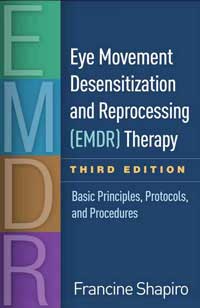 568 pages
568 pages18 CE credits
Course Enrollment
$290.00
Add to Cart
All exams are taken online. The exam for this course will be available in "My Courses" immediately upon enrollment. Note the book is not included.
The book is available for purchase from Amazon.
As an Amazon Associate we receive a rebate from qualifying purchases.
EYE MOVEMENT DESENSITIZATION AND REPROCESSING, 3RD EDITION
Basic Principles, Protocols, and Procedures
Francine Shapiro, Ph.DGuilford Press, 2017
DESCRIPTION
The authoritative presentation of Eye Movement Desensitization and Reprocessing (EMDR) therapy, this groundbreaking book--now revised and expanded--has enhanced the clinical repertoires of more than 100,000 readers and has been translated into 10 languages. Originally developed for treatment of posttraumatic stress disorder (PTSD), this evidence-based approach is now also used to treat adults and children with complex trauma, anxiety disorders, depression, addictive behavior problems, and other clinical problems. EMDR originator Francine Shapiro reviews the therapy's theoretical and empirical underpinnings, details the eight phases of treatment, and provides training materials and resources. Vivid vignettes, transcripts, and reproducible forms are included. Purchasers get access to a Web page where they can download and print the reproducible materials in a convenient 8 1/2" x 11" size.
New to This Edition:
•Over 15 years of important advances in therapy and research, including findings from clinical and neurophysiological studies
• New and revised protocols and procedures
• Discusses additional applications, including the treatment of complex trauma, addictions, pain, depression, and moral injury, as well as post-disaster response
•Appendices with session transcripts, clinical aids, and tools for assessing treatment fidelity and outcomes
EMDR therapy is recognized as a best practice for the treatment of PTSD by the U.S. Departments of Veterans Affairs and Defense, the International Society for Traumatic Stress Studies, the World Health Organization, the U.K. National Institute for Health and Care Excellence (NICE), the Australian National Health and Medical Research Council, the Association of the Scientific Medical Societies in Germany, and other health care associations/institutes around the world.
The reader will be able to:
• Describe an EMDR information processing model
• Analyze presenting problems in terms of image, negative and positive cognitions, emotions and physical disturbances
• Apply the eight phases of EMDR therapy, history, and treatment planning: preparation, assessment, desensitization, installation, body scan, closure, and re-evaluation
• Apply a three-pronged EMDR therapy protocol, choosing a target, patterns of response, and single-memory processing effects
• Create and apply EMDR protocols for single traumatic and for disorder- and symptom-based events in the treatment of anxiety, phobias, grief, illness and somatic disorders, pain, stress, noncompliance, PTSD, sexual abuse, combat trauma, couples relationship problems, addictions, dissociative reactions
AUTHOR
Francine Shapiro, Ph.D, the originator and developer of EMDR therapy, is Senior Research Fellow Emeritus at the Mental Research Institute in Palo Alto, CA, Executive Director of the EMDR Institute in Watsonville, CA and founder and President Emeritus of the Trauam Recovery/EMDR Humanitarian Assistance Programs. She is a recipient of the International Sigmund Freud Award for disintguished contribution to psychotherapy, the Award for Outstanding Contribution to Practice in Trauma Psychology from Division 56 of the APA and the Distinguished Scientific Achievement in Psychology Award from the California Psychologial Association.
EDITORIAL REVIEWS"This third edition provides an updated and comprehensive--yet very accessible--description of Shapiro's pioneering technique. Shapiro has consistently promoted research to substantiate the efficacy of EMDR therapy and has also incorporated the feedback she has received from both clinicians and clients. EMDR is a sophisticated, highly integrative treatment that draws from a variety of theoretical orientations. It is experiential and client centered, with the goal of assisting clients to reprocess and heal from their dysfunctional storage of trauma-based material. This book should be in the libraries of all clinicians--it has changed the way trauma is treated and has broad applicability to myriad other mental health conditions."
--Christine A. Courtois, PhD, ABPP, private practice (retired), Washington, DC; consultant and trainer, trauma psychology and treatment
"An excellent resource on an important evidence-based treatment for traumatic stress. This book is relevant for all practitioners interested in EMDR therapy, including novices as well as those who already use the approach. The third edition offers a wealth of detail to guide the reader in applying EMDR across a range of clinical presentations. Highly recommended."
--David Forbes, PhD, Professor, Department of Psychiatry, University of Melbourne; Director, Phoenix Australia--Centre for Posttraumatic Mental Health
"EMDR revolutionized the treatment of PTSD and has emerged as a front-line therapy for multiple forms of psychological trauma. The third edition of this foundational work underscores EMDR's integrative nature, research support, and sensitive adaptations to diverse populations. The clinical aids, client transcripts, and fidelity scales will prove a boon to practitioners and researchers alike."
--John C. Norcross, PhD, ABPP, Distinguished Professor of Psychology, University of Scranton
"It's not easy to take a classic and improve on it, but that's what Shapiro has done in this third edition, with her usual combination of incisive writing, scientific rigor, and deep compassion for human suffering. The strength of EMDR's research base is now available in one easily accessible place, a testament to Shapiro's decades of insistence that no matter how clinically useful EMDR therapy might be, it needs to be supported by empirical data. The book clearly describes applications to the range of posttraumatic responses as well as other clinical problems. It is truly a gift for clinicians--and our clients."
--Laura S. Brown, PhD, ABPP, past president, Division of Trauma Psychology, American Psychological Association; private practice, Seattle, Washington
"The third edition expands on EMDR's proposed mechanisms of action and presents updated research beyond posttraumatic stress disorder, including applications for complex problems such as addictions and dissociative disorder. It is especially encouraging to see the link between trauma and addiction made clear, given the worldwide epidemic that addiction has become."
--Susan Brown, LCSW, private practice, La Mesa, California
ISHK CE at Home
1702-L Meridian Ave., #266
San Jose, CA 95125-5586
This website uses cookies to ensure you get the best experience on our website. Learn more
